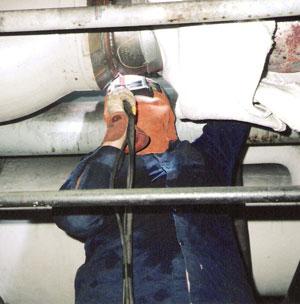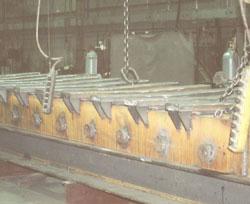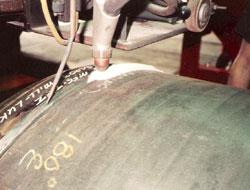AWS CWI, CWE, NDE Level III
- FMA
- The Fabricator
- FABTECH
- Canadian Metalworking
Categories
- Additive Manufacturing
- Aluminum Welding
- Arc Welding
- Assembly and Joining
- Automation and Robotics
- Bending and Forming
- Consumables
- Cutting and Weld Prep
- Electric Vehicles
- En Español
- Finishing
- Hydroforming
- Laser Cutting
- Laser Welding
- Machining
- Manufacturing Software
- Materials Handling
- Metals/Materials
- Oxyfuel Cutting
- Plasma Cutting
- Power Tools
- Punching and Other Holemaking
- Roll Forming
- Safety
- Sawing
- Shearing
- Shop Management
- Testing and Measuring
- Tube and Pipe Fabrication
- Tube and Pipe Production
- Waterjet Cutting
Industry Directory
Webcasts
Podcasts
FAB 40
Advertise
Subscribe
Account Login
Search
Use and weldability of high-chromium molybdenum steels
- By Professor R. Carlisle "Carl" Smith
- September 10, 2012
- Article
- Metals/Materials
At least a dozen chromium molybdenum (CrMo) steel combinations exist. One of the more recent alloys consists of chromium, molybdenum, vanadium, niobium (columbium), and nitrogen. Beginning sometime in the 1970s, this material became popular for use in high-temperature applications, such as gas and coal-fired power plants. However, it is not intended to replace other CrMo types. Each alloy has its own place in the high-strength, low-alloy group of materials.
Composition
All alloys vary in composition, but ASTM and ASME guidelines specify a range of percentages for the elements in each. This chart shows the nominal percentages for the P-91 type.
|
Type
|
C
|
Mn
|
S
|
P
|
Si
|
Cr
|
Mo
|
|
9Cr-1Mo
|
0.15
|
0.30-0.60
|
0.030
|
0.030
|
0.20-0.50
|
8.0-10.0
|
0.85-0.105
|
|
9Cr-1Mo*
|
0.08-0.12
|
0.30-0.60
|
0.010
|
0.020
|
0.20-0.50
|
0.800-0.950
|
0.85-1.05
|
*Also may contain 0.18-0.25 vanadium (V); 0.06-0.10 niobium/columbium (Nb/Cb); and 0.03-0.07 nitrogen (N).
The alloy containing V, Nb/Cb, and N is a purer combination of elements. The lower carbon, sulfur, and phosphorus content requires stricter refinement. At first glance, it appears that with its lower carbon (C) content, the vanadium-bearing type would have a lower tensile strength. However, the vanadium makes the tensile strength higher. ASME Section IX specifies a minimum 60,000 PSI for the nonvanadium type and 85,000 for the vanadium-bearing type.
Note that P-91 is not an ASME “P” number designation. The “P” number for the nonvanadium type is P-5B, and the vanadium-bearing type is P-15E. It also should be noted that the Unified Numbering System (UNS) differentiates the types as well. The nonvanadium-bearing type is listed as K90941, and the vanadium-bearing type is listed as K90901.
Uses
The 9Cr-1Mo material is prevalent for burning nozzles in power plants and other high-temperature applications because of its creep resistance—its ability to maintain tensile strength at elevated temperatures. The 9Cr-1Mo with V, Nb (Cb), and N is even more resistant to creep and high-temperature hydrogen attack. These additions cause the material to maintain its tensile strength even at sustained high temperatures in boilers, furnaces, and furnace cars.
When working with any used CrMo material (Figure 1), particularly 9Cr-1Mo, you must take extra care. Take into consideration the temperature the material has been exposed to and the length of time it has been in-service and out-of-service. The material is sensitive to hydrogen attack, and certain applications cause it to be even more prone to hydrogen cracking.
In-service history should be evaluated based on repetitions of heating and cooling, exposure to certain atmospheric conditions, and data reports for any intermediate repairs or alterations that may have been performed.
Some out-of-service conditions that can affect the material are incorrect handling, such as lifting and turning; and exposure to extreme atmospheric conditions, such as excess moisture, chemicals, and temperature variances.
Cleaning used material is extremely important. Foreign materials, especially those that produce carbon, can cause serious problems during welding. It often is advisable to blast the material to near white and then apply a chemical cleaning process before welding.
Welding Considerations
Although welding equipment suppliers, handbooks for welding, and other sources say these alloys are readily weldable, extreme care and caution are highly suggested. The very nature of 9Cr-1Mo—its susceptibility to hydrogen attack that can cause delayed cracking, and a limited availability of weld materials, to name a couple of trouble spots— indicates the need for special cleaning, preheating, postheating, and postweld heat treatment.
Before beginning a project using any material, it is important that you obtain a copy of the material test report (MTR). It is critical to determine whether some of the elements are on the high or low end of the allowed range in the specification. A typical analysis is not sufficient for determining the projected behavior of the 9Cr-1Mo material. The heat-treatment methods used to produce the material must be considered. For example, was it annealed, quenched and tempered, or purchased as rolled or extruded?
The mechanical properties such as tensile strength, yield strength, elongation, and reduction of area also are important in reference to the material’s ductility. This information helps you determine the appropriate welding process, the filler metal type, the preheat and the postweld heat treatment (PWHT) temperatures (1,350 degrees to 1,425 degrees F), and method to use.
Charpy V-notch tests also can be very useful for determining the material’s toughness.
As previously mentioned, because the material is susceptible to hydrogen attack, cleaning is critical. The weld area and at least 4 inches on each side of the weld should be superclean. The welding procedure should specify cleaning methods, such as blasting, grinding, wire brushing, and/or chemical. A good chemical may be the citrus type recommended for weld cleaning.
Preheating
Preheating is not an option! It is a must! The minimum preheat and interpass temperature must be at least 350 degrees F for materials less than 0.500 in. thick and 450 to 550 degrees for greater thicknesses. The preheat temperature must be carefully maintained until the welding is completed. One of the most frequent problems with welding this material is allowing the heat to diminish ahead of the weld. This is especially true with thicker material.
The method of preheating (whether by local torch heating, furnace, or electrical wrap) should be based on the overall size, thickness, and, of course, available equipment. A finely controlled thermo-recordable method always is preferable to the local torch method. This resistance-type equipment typically is readily available for rent.
When performing large fabrications, such as furnace cars with SA387-Gr91, the preheating process is more difficult. It usually is not possible for a small to medium-sized fabricator to place 20- to 30-ft.-long parts in a furnace. The resistance heating method is a good choice in these cases. The blanket can be lifted in the area to be welded without cycling the heat throughout the whole part. This is very handy for welding in the small bosses and other attachments. These parts can be placed in a small furnace until they are ready to be welded to the main structure (Figure 2).
Electrodes and Filler Metals
Use low-hydrogen electrodes and filler metal with this material. Some preferred electrodes for welding 9Cr-1Mo with shielded metal arc welding (SMAW) are E505-1X (produced to be corrosion-resistant), E8018-B8, or B8L.
For the solid-wire processes—gas tungsten arc welding (GTAW) and gas metal arc welding (GMAW)—use ER505 or ER80S-B8. Submerged arc welding (SAW) also uses the same classification of wires and a suitable flux.
For flux-cored arc welding (FCAW), E505T-1 or T-2, E815-B8, or E60T5-B8L can be used. However, there is some concern about the Charpy impact values and FCAW wires.
For 9Cr-1Mo with V, Nb/Cb, and N, the preferred SMAW electrodes are E9018-B9 or E9015-B9. The E9015-B9 electrode is less likely to cause hydrogen attack because the coating does not contain all the elements, such as iron powder, that absorb hydrogen. The same processes, electrodes, filler metals, and flux can be used for welding SA387-Gr9 and SA387-Gr91.
Use ER90S-B9 filler metal when welding 9Cr-1Mo containing V, Nb/Cb, and N with GTAW and GMAW. This wire is unlikely to cause hydrogen problems, especially with GTAW. The same filler metal may be used for SAW. The filler metal also minimizes the possibility of hydrogen attack with the SAW process, provided the flux is kept hydrogen-free by continuous drying. Using a vented heater in the flux hopper is a good way to prevent moisture. The flux should not be reused when welding this material (Figure 3).
Relatively few fabricators are familiar with this material. Although it can be fabricated and welded satisfactorily, you need to understand the material and its requirements fully before welding.
About the Author

Professor R. Carlisle "Carl" Smith
Weld Inspection & Consulting
PO Box 841
St. Albans, WV 25177
304-549-5606
subscribe now

The Fabricator is North America's leading magazine for the metal forming and fabricating industry. The magazine delivers the news, technical articles, and case histories that enable fabricators to do their jobs more efficiently. The Fabricator has served the industry since 1970.
start your free subscription- Stay connected from anywhere

Easily access valuable industry resources now with full access to the digital edition of The Fabricator.

Easily access valuable industry resources now with full access to the digital edition of The Welder.

Easily access valuable industry resources now with full access to the digital edition of The Tube and Pipe Journal.
- Podcasting
- Podcast:
- The Fabricator Podcast
- Published:
- 04/16/2024
- Running Time:
- 63:29
In this episode of The Fabricator Podcast, Caleb Chamberlain, co-founder and CEO of OSH Cut, discusses his company’s...
- Trending Articles
Steel industry reacts to Nucor’s new weekly published HRC price

How to set a press brake backgauge manually

Capturing, recording equipment inspection data for FMEA

Are two heads better than one in fiber laser cutting?

Hypertherm Associates implements Rapyuta Robotics AMRs in warehouse

- Industry Events
16th Annual Safety Conference
- April 30 - May 1, 2024
- Elgin,
Pipe and Tube Conference
- May 21 - 22, 2024
- Omaha, NE
World-Class Roll Forming Workshop
- June 5 - 6, 2024
- Louisville, KY
Advanced Laser Application Workshop
- June 25 - 27, 2024
- Novi, MI





























